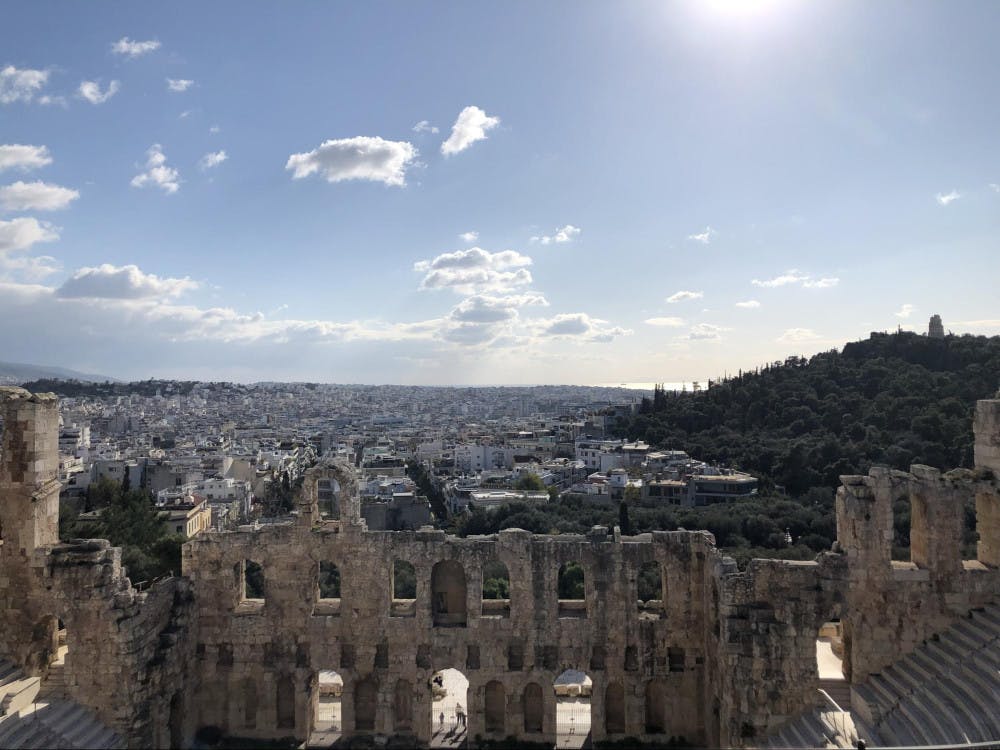By: Elizabeth Weber
Γειά σου! This is the phrase for hello, something you would hear while bustling through the streets of Pláka, snacking on a chocolate croissant on the way to class, or exploring the many archaeological sites that represent what we usually think of as Greece. While Greece is known for the famous Acropolis or its beautiful Greek Islands, its culture and presence does not stop with Alexander the Great.
Acropolis
This January, I had the amazing opportunity to take a Modern History course which covered the early 1900s to 1974 through the American Institute for Foreign Study, or AIFS. Here, we learned that the Greek culture we see today was formed by the 1.5 million refugees that planted roots in Greece after the Asia Minor Catastrophe of 1922. Greece had also faced multiple dictatorships, fought in numerous wars and remained true to their culture during Nazi occupation during WWII. At Deree, The American College of Greece (ACG), besides the wonderful history that I learned, I was able to see how sustainability is addressed in Greece and how it differs from the United States’ initiatives.
National Garden
One of the first differences that I noticed was the large displays explaining what to recycle and why to recycle. These displays made it very clear what was recyclable, and even the trash seemed to question if you were making the right choice by throwing something away. Their initiative, ACG Cares, illustrated that they connect sustainability and education. Through the use of visual elements, I had little difficulty navigating recycling in Athens.
Deree - American College of Greece

Deree - American College of Greece
I spoke to Professor Anna Degleri about her thoughts on sustainability in Athens. She said that “Sustainability in Greece is still an ongoing process as more and more people become aware of the necessity to save our planet. I remember that ten to fifteen years ago, people did not know how important recycling was; today, it's part of our life. Sadly, we still depend on old sources of energy like lignite, but not for much longer.” One of the ways Professor Degleri thought that the Greek Islands could become more sustainable was through the harvesting of wind energy. With the Four Winds from Greek mythology, Boreas, Eurus, Notus and Zephyrus, it makes sense that Greece has established windmills in the vast mountain regions and on some of its islands. I specifically saw these windmills in the mountains on the way to Delphi; however, our guides claimed that it has caused some disagreements over ruining the pristine landscapes.
Distomo
In 2019, 22 percent of Greece’s electricity generation came from renewable resources. Solar photovoltaics accounted for 8.2 percent of total electricity generation, and wind energy produced the rest. In addition, 15.2 percent of its final energy consumption is made up of renewable resources; however, Greece’s target is to reach 20 percent by 2020. This goal will be accomplished by an increased use of windmill power and a decrease in the use of lignite as an energy source. Because Greece is part of the European Union, it conforms to the body’s environmental legislation, but it is clear that Greece has made great strides by itself.From Agia Paraskevi, where I stayed in the college apartments, to Syntagma Square in downtown Athens, it took about an hour with a metro ride and a bus ride. Athens has over 135 kilometers (84 miles) of metro line, which removes 375,000 cars per day from the busy streets. The metro was super easy to use with just a swipe of a card, and it was also full of people traveling to work and various other places. There are still plenty of cars in Athens where pedestrians do not get the right-of-way, and many parking spots were questionable. Most cars were also a lot more compact in Greece.
On our way to classes from Agia Paraskevi.
Finally, in Glyfada I visited the Sea Turtle Rescue Centre. This is a rehabilitation facility for sick and injured turtles. The Centre’s objectives include research and monitoring of sea turtles in order to provide better protection. In addition to monitoring around 75 kilometers of major nesting beaches, the Centre tags sea turtles to monitor movements, and rehabilitates injured sea turtles. They focus on “public awareness and environmental education” and have a really thought-provoking display of all of the trash and pollution they have found in sea turtles that enter their care. I thought this was a very amazing way to show the impact that humans have on the ecosystems, and it was an educational opportunity that I will never forget.
ARCHELON: The Sea Turtle Protection Society of Greece
Overall, studying abroad in Greece was a truly amazing opportunity. I was able to learn about the history of modern Greece, which is something that is not as focused on in European history classes, and I saw how sustainability flourishes in Athens. I met an amazing group of people whom I adventured with and gained many skills that will impact me for the rest of my life. I want to end with Professor Degleri’s overall perspective: “I hope that we all understand that sustainability is our last chance to save the planet.” Sustainability is a concept that transcends boundaries, and we all need to find ways to integrate it into our lives- no matter where we are in the world.
Temple of Poseidon

Santorini

Delphi
All photos courtesy of Elizabeth Weber

